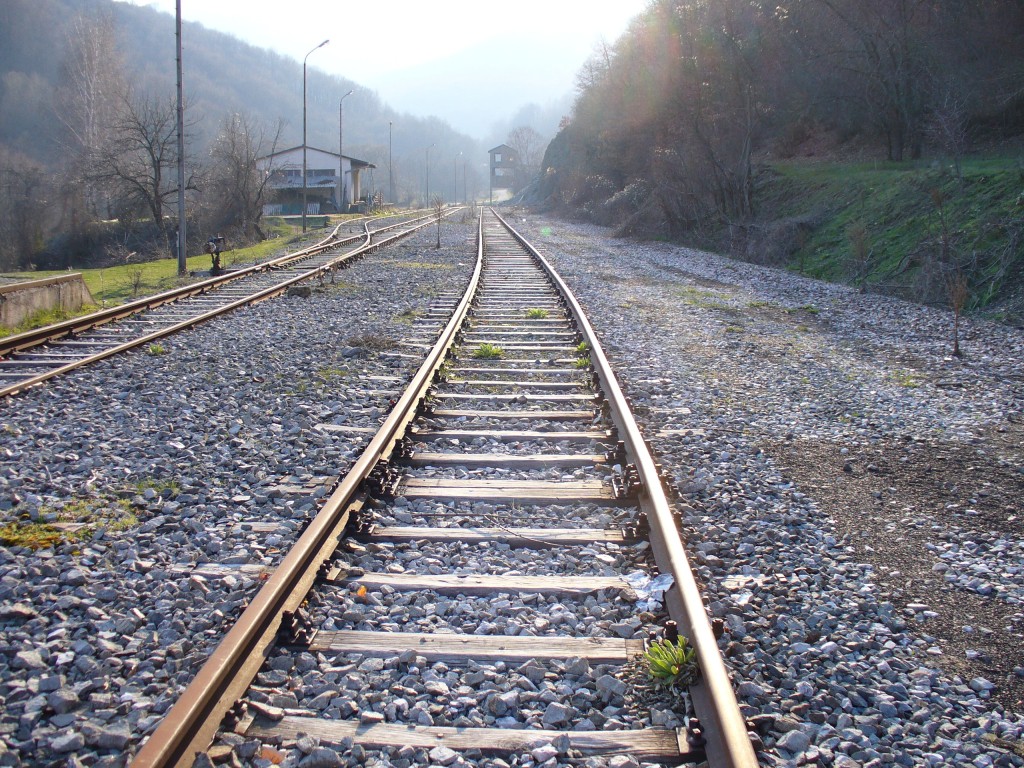Why do migrants get killed so much on the railway tracks in Macedonia?
Published in Analyses
on 6 - 05 - 2015 Author: Мирјана Најчевска
- Railways as migrants’ graveyards. Photo: Novica Nakov, 2007 (CC BY-SA).
How come so many emigrants get killed on the railway tracks in Macedonia all of a sudden. Why previously the number of killed persons was much lower? What has changed?
By Prof. Mirjana Najcevska, PhD, human rights expert
- Yet another illegal migrant died at the railway track in Veles,
- 7 migrants died on Macedonian railway tracks,
- Another migrant died in an accident at the railway tracks,
- 14 migrants died on the railway tracks near Veles, …
Continuous increase of number of people who illegally enter Macedonia and get killed on the railway tracks attracted the interes of the media. Some of the media got interested in wider implications of the issue of the relations of the state towards the people seeking asylum, or are just attempting to cross through Macedonia and move further. The issue concerns one of the most marginalized group in the world: refugees, illegal migrants, asylum seekers. The usual attitude of the public towards these groups is rejection, ignoring, or in the best case, pitying. Media in Republic of Macedonia do not incite direct rejection or ignoring of these people (even though some of the messages sent through the media can be interpreted in that manner). For instance, the article “Sad: They run from death for thousands of kilometers, only to die in Veles” states:
„Is anybody guarding the Macedonian border or it is really so easy to cross from Greece to Macedonia on foot, by car or by train?
Migrants, mostly from Syria or Afghanistan, who for a longer period of time forced by their hardships to cross into Macedonia in waves, traveling towards European countries, show that anyone can enter this country at will.
Even though the authorities recently keep discovering hundreds of migrants loaded in railroad cars like the Nazis loaded the Jews, it appers that our border is like a free movement zone.” (See also: “MOI: Greece should cover the border better”)
However, very few media ask questions, and even fewer media analyze and put them in context of existing laws and standards of international agreements, and even less demand responsibility and action from the state. Even in situations when there’s obvious breaking of ratified conventions (for instance, the Convention of the Rights of the Child), the media do not ask questions about the measures taken by the state to protect these people, instead of the issue of protecting the state borders:
- Seven migrants died, including a 45-days old baby, in two weeks on the Macedonian railways: “On November 5, on the Skopje-Gevgelija railway, at the place called Javorica, an Afghan man aged between 20 and 25 died together with his son who was only 45 days old.”
The lack of interest by Macedonian media to analyze these situations from legal and criminology perspective is even more impressive. For instance, no media asked the question if these are indeed railway accidents? Namely, only an individual investigation and a detailed autopsy can confirm whether the cause of death of a human being was being hit by a train, as opposed to being murdered, beaten to death, robbed, and raped, and then left for dead on the railway tracks or tossed nearby. This type of analysis must be applied, especially when death of babies and children is concerned, as well as elderly or women. Consider the example of a young Nigerian woman found in a canal next to the railway tracks near Demir Kapija. Many media reported about this case:
“Yesterday the body of a young female emigrant from Nigeria was found in a canal next to the railway track near Demir Kapija. According to the Ministry of Interior announcement, around 10:30 hrs, an employee of Macedonian Railways who operated the engine about 200 meters from Miravci railway station on the Skopje-Gevgelija railroad, noticed unknown corpse in a canal. Crime scene investigation was done by Police Station Negotino. They found out that the body belongs to Grace E. (29) from Nigeria, who had suffered head injuries – a fracture from a blow, most probably by a train. By order of the Public Prosecutor, the body was given to the funeral parlor in Negotino, for burial at the city cemetery.”
The term “most probably”” was used by all media that reported about this case. However, no media expressed interest to ask the police how they confirmed that the women was not murdered, nor robbed, that she had not been previously raped and then thrown in a ditch. Interestingly enough, most of these media repeated the phrase:
“Crime scene investigation was done by Police Station Negotino. They found out that the body belongs to Grace E. (29) from Nigeria, who had suffered head injuries – a fracture from a blow, most probably by a train. By order of the Public Prosecutor, the body was given to the funeral parlor in Negotino, for burial at the city cemetery.”
Furthermore, no media asked why did the police conduct the investigation, when that is the domain of the Public Prosecutor? What was the basis for the Public Prosecutor’s decision to order the immediate burial? And why an autopsy has not been conducted, even though it is obligatory in case of violent death? This implicates that women who illegally enter Macedonia can be freely raped and murdered without any consequences, if their bodies are then thrown near some railway tracks. One of the roles of the media is to identify problems. In case of immigrants that recently keep getting killed in “railway accidents” in Macedonia, there are number of problems that may incite their interest. There are several positive examples of analysis which use multilayer approach towards this problem, such as
- “Macedonia murderer of migrants”,
- “Exclusive reportage by Telma: Migrants’ Golgotha”,
- “Bloody tracks”.
Questions that demand answers include:
- How come so many emigrants get killed on the railway tracks in Macedonia all of a sudden. Why previously the number of killed persons was much lower? What has changed?
A short analysis by TV Sitel entitled “Number of illegal imigrants in the country has doubled in a year” goes into this direction.
- Has proper investigation and proper forensic autopsy been conducted? Has the individual cause of death been determined for each of the people found on or near the railway tracks?
- Can there be doubt about murder or murders?
- Has each individual case been followed up by a note to the appropriate state (if there are documents enabling identification of the victims’ identities)?
- How do authorities determine the religion of the deceased, to enable burials according to the proper rites?
After receiving answers to these questions, one can ask for the state to conduct the appropriate action, responding to the real, and not some imaginary problem. Because, according to the Constitution of Republic of Macedonia:
The human right to physical and moral dignity is irrevocable. (Article 11)
The Republic particularly protects mothers, children and minors. (Article 42)
Also, according to the Law on Health:
Not a single deceased person, nor a stillborn child, may be berried prior to conducting a medical examination or an autopsy, and the cause of death is determined. (Article 267)
When there’s reasonable doubt, or it is obvious that the death did not occur from natural couses, the body of the deceased person must be subjected to forensic autopsy and forensic examination by two medical doctors, including at least one MD specialized in forensic medicine. (Article 275)
This analysis was created within the framework of the USAID Media Strengthening in Macedonia Project – Media Fact-Checking Service Component, implemented by Metamorphosis. The analysis is made possible by the generous support of the American people through the United States Agency for International Development (USAID). The contents are the responsibility of its author and do not necessarily reflect the views of Metamorphosis, USAID or the United States Government. For more information on the work of USAID in Macedonia please visit its website (macedonia.usaid.gov) and Facebook page (www.facebook.com/USAIDMacedonia).

